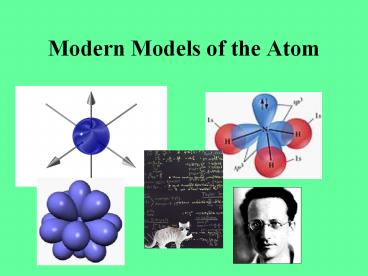Modern Models of the Atom - PowerPoint PPT Presentation
1 / 32
Title:
Modern Models of the Atom
Description:
Modern Models of the Atom Modern Models of the Atom Experiments show that light must be waves! Other experiments show that light consists of particles! – PowerPoint PPT presentation
Number of Views:169
Avg rating:3.0/5.0
Title: Modern Models of the Atom
1
Modern Models of the Atom
2
(No Transcript)
3
Experiments show that light must be waves!
4
Other experiments show that light consists of
particles!
5
Louis de Broglie Suggested that all particles
have a wave nature and that things like light
and electrons could be particles or waves!
6
(No Transcript)
7
De Broglies model of the atom. Electrons are
like waves as they go around the atom.
8
(No Transcript)
9
ErwinSchrodinger
10
The Schrodinger Equation
Schrodinger used mathematics to predict how
electrons behave in an atom!
11
(No Transcript)
12
Orbital movies
An orbital is a region in space where the
probability of finding an electron is high. The
denser the orbital, the higher the probability.
13
A 1s orbital
14
Each energy level of the hydrogen atom has a
certain number of orbitals available for electrons
15
Energy
16
Energy levels are designated by a quantum number
called n the principal quantum number Level
n1 has just the 1s orbital
17
The n2 level has 4 orbitals, a 2s (same shape
but larger than a 1s) and three 2p orbitals
Orbital movies
18
(No Transcript)
19
N3 level has one 3s, three 3p orbitals and five
3d orbitals. Each level n has n2 orbitals
Orbital movies
20
The five 3d orbitals chime d-orbitals more
21
Level n 4 has a 4s, three 4p orbitals, five 4d
orbitals and seven 4f orbitals
Orbital movies
22
The 4f orbitals
23
Energy Level Diagram for Hydrogen
n 4
n 3
Energy
In a hydrogen atom, all the sublevels of each
energy level n have the same energy. Eg 2ps
are at the same energy as 2ss3ss, 3ps and
3ds all have the same energy etc
n 2
n 1
24
java orbitals
In many electron atoms (atoms other than
hydrogen), the sublevels have different
energies. Eg the 2p orbitals have slightly higher
energy than the 2s. The 3ps are higher than the
3s and the 3ds are higher still.
25
(No Transcript)
26
In 1969, Professor Murray Gell-Mann received the
Nobel Prize in physics for his work on the theory
of elementary particles he found that all of
those particles, including the neutron and
proton, are composed of fundamental building
blocks that he named "quarks."
The quarks are permanently confined by forces
coming from the exchange of "gluons." He and
others later constructed quantum
chromodynamics," which seems to account for all
the nuclear particles and their strong
interactions." ...
27
Quantum Chromodynamics
Protons and Neutrons are composed of smaller
particles called quarks
28
A proton consists of two up and one down
quark.
29
Flavors of quarks
30
Different combinations of quarks produce
different particles
31
Quarks are held together by gluons
32
Will it ever end?































